Last month, I had the pleasure of visiting Scenic Heights Elementary School in Minnetonka, Minnesota to speak to their fifth grade students about Sachiko. There was something unusual about how the kids responded to my presentation describing Sachiko’s life as a survivor of the Nagasaki atomic bomb and her pathway to peace. Only ten and eleven, these fifth graders “got” the importance of Sachiko’s story. They asked deep and empathetic questions. They continued to ask me questions even after an hour of sitting, even when their class was dismissed, even through my website email the next day. What was happening at Scenic Heights Elementary? I was curious to find out what.
I asked fifth grade teacher Summer Wood and media center specialist Melinda Barry to describe the peace program at Scenic Heights.
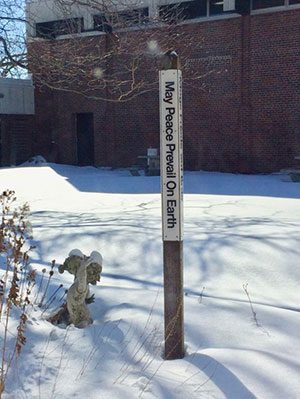
In 1996, Scenic Heights became an International Peace Site and an early member of World Citizen, a nonprofit peace education organization. In the words of teacher Summer Wood, “…since then the concept of peace has continued to keep the school grounded.” But it takes more than a peace pole to establish a school culture of peace. It takes vision, commitment, and tangible programming throughout the school, throughout the year.
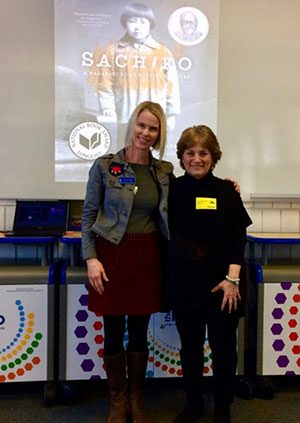
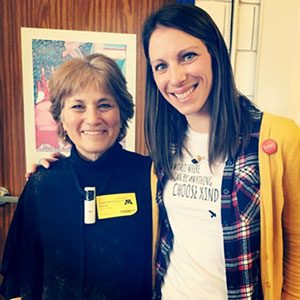
I realize not every school has the resources available to Scenic Heights, but every school can create a vision of peace and commit to working toward it. How does the staff at Scenic Heights work toward their vision of peace?
I asked teacher Summer Wood if she and her fifth graders would team with me to write this blog to help describe the peace program at their school. Summer agreed and so did her kids. The students’ perspectives were critical. Who else but the kids could best explain the impact of their school’s peace program on them?
To begin, I emailed Summer five questions. For each question, Summer wrote a short answer then added the students’ own responses along with their self-portraits. The responses are tender, heartfelt, and worth the scroll down to read the entire blog. Enjoy!
When I was at Scenic Heights I learned that every day students at Scenic Heights say a pledge for peace. What is that pledge? What do you think about when you say the peace pledge? Do you think it helps make the school a better place to be? Can you explain your thoughts about this? — Caren
Peace Pledge:
I am a peace maker.
I treat myself and others with respect.
I listen.
I share.
I care for the Earth, air, water, plants and animals.
I am important in this very big world.
I know peace begins with me.

- When I say the pledge I feel calm and relaxed. Saying the peace pledge makes us feel joy and peace when we are having a rough day. It makes us feel safer, in a school of peace and love. — Marin
- When I say the peace pledge, I think of peacemakers, such as Gandhi and Malala, and what they did to make the world a better place. — Anna
- I think that the peace pledge helps us every morning by reminding us to be peaceful to others. — Kennedy
- I think the peace pledge helps us notice how we can help others. — Nicole
- I think about all the animals and plants and trees and all of nature and the peace in the world. — Delaney
- I think the pledge helps us think more about peace and other people the pledge is about peace, learning and thinking. — Kimyra
- I think the peace pledge is to make you think about peace and how to make the world a better place. — Andrew
- When I say the peace pledge I think of making the world a better place. — Meredith
- I think it helps some people as in the people that say like they mean it and makes me feel better. — Addy
- When I say the peace pledge I think about making my school and the world a better place. — Rory
- I think the piece pledge it make you think about what you can do to make the world a better place. — Peter

When I was at Scenic Heights I learned that Scenic Heights has an “anti-bullying program.” What does “anti-bullying” mean to you? Can you give an example of what you’ve learned? Does your school’s anti-bullying program give you courage to stop others from bullying? — Caren
*We currently use the OLWEUS curriculum to teach students about bully prevention. We also have a Social and Emotional Learning (SEL) team at our school that helps to develop lessons and offer suggestions and learning tools for all staff to use. This year we have a full time social worker and two part time counselors. The counselors come in to the classroom once a month to teach SEL lessons to each class.
Each Friday, on the morning school news station, we recite the anti-bullying rules:
“We will not bully others.
We will treat others with respect.
If we know that someone is being bullied, we will tell an adult at school and an adult at home.”
— Summer Wood
- Anti-bullying to me, is making sure nobody feels left out, or afraid to be who they truly are. I’ve learned that there is still so much bullying, but we can save the victims of bullying. By helping them feel safe and wanted. Our school’s Anti-bullying program has given me more than enough courage to stand up against bullying. — Marin
- To me anti-bullying means to stick up for others and be KIND to people and to spread love not hate. I think our anti-bullying program stops people from buying because they know how hurtful and how much damage it can do to people. — Delaney
- I think people bully others because they are they are hurting inside. I think are anti bullying program helps stop bullying. — Kennedy
- I love the anti-bullying and if we did not have it I don’t think much people would want to go to school. — Addy
- I read in a book once that the people who are bullying someone just need a little extra love, and I agree. So even if someone is bullying you, just try to be nice to them and they might change their attitude. — Anna
- To me Anti-bullying means NO bullying, No teasing, and NO ONE ever feeling sad and that if we stop bullying the world will be that much happier. — Olivia
- Anti-bullying to me means standing up for others who can’t stand up for themselves. I have no example to share but the anti-bullying program has made me stand up for people. — Andrew
- I think our schools Anti-bullying program is really helpful to stop bullying. Anti-bullying means to me is to prevent bullying. — Gus
- Anti-bullying is a real thing and I think that the anti-bully program has made are school a better place. — Meredith
- Anti-bullying I think is a great thing I think if everyone got the message the world would be a much better place. — Peter
- I think it’s good because It helps people not get bullied as much compared to other schools. — Rory
- Anti-bullying I think is about people who don’t like each other an example is “you’re really ugly go sit somewhere else” Anti-bullying should be for people to stand up to each other. — Kimyra
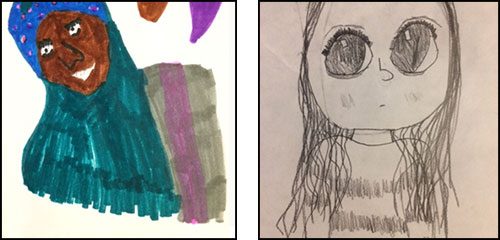
When I was at Scenic Heights I learned that kids participate in service projects. What kind of service projects have you and your classmates been involved in? Has participating in service projects changed your thinking about helping others? If so how? — Caren
- Some of the service projects that we take part in are the ICA food drive, collecting and donating hats and mittens, Trick or Treat for Unicef, Toys for Tots, making comfort kits for homeless shelters and the Pennies for Patients fundraiser. Each grade level usually “takes on” a service project and promotes it school wide. At the peace assembly each year, students from each grade level explain what the service project did and what the result was. It is powerful listening to students speak in both English and Chinese about the service they did. (Scenic Heights offers a Chinese immersion program) — Summer Wood
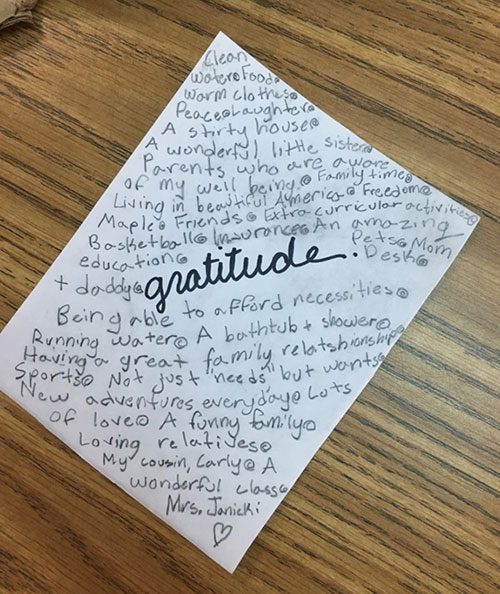
- A service project I have done was making comfort kits. We packed bags filled with soap, razors, deodorant, toothbrushes, toothpaste, etc. We then gave the kits to homeless shelters. This project has definitely changed my thinking about helping others. It makes me feel thankful for all the necessities we are able to afford. — Marin
- A service project I have done is the comfort kits where me and 5th grade classes packed Towels, Toothpaste, Toothbrushes, etc. It changed my outlook on helping people. And also made me want to help out more with the homeless because I feel they should have some food in their bellies. — Andrew
- Some service projects I have done with my classmates are the Toys for Tots fundraiser and the comfort kits, which helped people at homeless shelters stay clean. Each one had a special quote or message inside to make them feel good. — Anna
- My favorite service project was when we made food packs for families that had been hit by hurricane sandy. At the time I didn’t really understand why we did it but now I do. Those people’s homes were destroyed they had nowhere to go and not a lot of food. And now I am so so so thankful for all I have and that I have a nice warm home to come to and in a good neighborhood. — Delaney
- A service project I have participated in is the Toys for Tots fundraiser. It has changed my life forever because I felt like I was really giving back to so many kids. — Meredith
- A service project that I have done is toys for tots I think Toys for Tots for me is about helping other kids who don’t have toys or family. — Kimyra
- A service project that I have done is comfort kits. Comfort kits is packing soap, toothpaste, toothbrush and more. Being involved in service projects has made me feel better knowing that I have helped people in need. — Gus
- I always feel like it is good to do kind things for people. And the service projects do that. You can participate in doing kind things for other people. You can get together to give things that you think are just normal to us but special to others. — Graham O.
- We have done Feed My Starving Children and it makes you really appreciate how lucky we are to live in such a good community. — Peter
- We do lots of service projects but I liked the comfort kits and helping people get jobs. — Addy
- When it was valentines we made kindness kits for homeless people I think that helped us think about kindness. — Kennedy
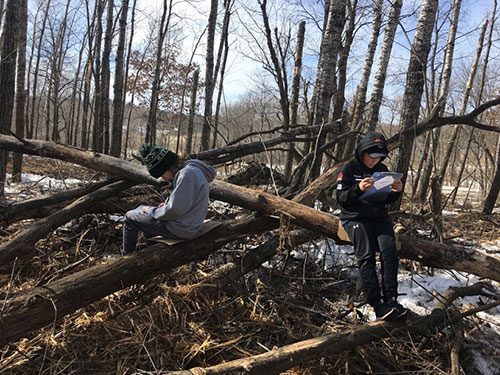
When I was at Scenic Heights I learned that your school has an environmental learning program. How do you think peace is related to learning about and taking care of the environment? — Caren
- We partnered with the Three Rivers Park District, Richardson Nature Center send environmentalist to our school to help educate the students three times each year. Once in the fall, winter, and spring. In 5th grade they do an invasive species lesson in the fall, winter survival skills in the winter, and they bring raptors in the spring and talk about the raptors found in the area and how to help protect them. The Outdoor Learning Center (OLC) is available to teachers all year. This year my personal goal was to get students connected with nature more often. Most Wednesday’s my class does ‘Wilderness Wednesday’, which quickly became everyone’s favorite subject. During this time we have gone for hikes, went “bowling” with snowballs, invented new winter games, brought books to read, and have done a gratitude practice sitting in nature. It really is amazing to see what fresh air and the time for students to use their imagination can do. — Summer Wood
- When I go to the OLC, I like to just stop and look around and see the happy birds and squirrels playing in the trees and I like to smell the fresh smell of nature. If there was no peace the animals would get mad and fight. And when we are in nature we need to respect the animals and the plants and care for them, and if we didn’t the trees will be cut down and there will be no place for us to go and relax. — Delaney
- I think peace is involved when we visit the OLC, because we are taking care of the fragile plants and animals. We learn to care and love for the earth we have. — Marin
- I think peace is involved with the OLC because we learn how to take care of the planet and it’s other inhabitants such as humans, animals and plants. — Andrew
- I think that peace is involved in nature because it teaches us caring for are environment and I think that most people will pass it on to their classmates. — Meredith
- You can just connect to nature and in the summer it is a beautiful forest and we can learn so much about nature and how to protect it. — Peter
- I think the OLC is involved with peace, because we learn about what we can do to take care of our planet. There’s only one planet suitable for life so where would we go if we couldn’t take care of it correctly? — Anna
- Peace is involved in this because when you get to go outside and do projects at the OLC you get respect, peace, and friends to work with. — Kimyra
- You learn about taking care of our planet. — Graham O.
- The OLC is a place for us to learn about nature and how to take care of it. — Addy
- I think that the OLC helps us think about not littering and polluting the earth so that it stays great. — Kennedy

Do you think having a Scenic Heights peace program helps kids understand the importance of Sachiko’s story, not only as a story of war but about a story of peace? What are your thoughts on this? — Caren
- I think the peace program helps us understand Sachiko’s story, because we learn what power peace can have on this world. We live in a world where destruction and mess are around every corner. But if we make peace in earth, then we can calm any storm. We are peacemakers at this school. — Marin
- I think the peace program helps us understand Sachiko’s story more. But at almost every corner on this world misery and destruction but if WE change our ways in this world, our one and only world we can make this beautiful world so peaceful. — Andrew
- I think every 5th grader in the world should read Sachiko because it is a great historical, peaceful, and hard book to read. — Kennedy
- I think it helps us understand peace, because so much of the story is war-torn and sad. It’s so refreshing to see peace peek through once in a while, and helps us understand its importance. — Anna
- Yes because we know what peace is and have that same longing for worldwide peace and now how we can be peace makers and help make the world a better place for everyone. — Olivia
- Yes because it tells people that anyone can make a difference. — Delaney
- Yes, because Sachiko is a really important person in this story and in other people’s lives but I think we should ask Sachiko some questions about us. — Kimyra
- I think that the peace at our school has helped me with this book of understanding Sachiko’s story. — Meredith
- I think the peace program helps our school understand Sachiko’s story and peace. — Graham O.
- I think her story is really touching just understanding what she has been through. When we think of America we think of this perfect country but after you hear Sachiko’s story it makes you realize that America isn’t so perfect. — Peter
- Yes, if everyone knew they would probably not take stuff for granted that much. — Addy
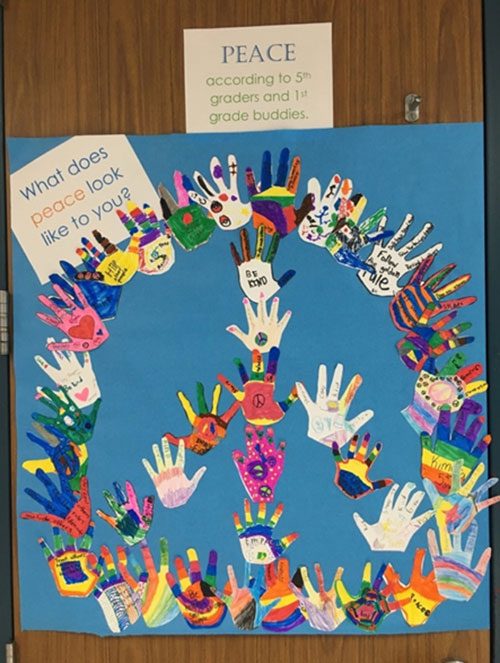
Mahatma Gandhi said, If we are to teach real peace in this world … we shall have to begin with the children. After visiting Scenic Heights Elementary and being awed by both the speeches of the student survivors at Parkland, Florida’s school shooting and the recent nation-wide, youth-led “March for Our Lives,” I would revise Gandhi’s famous statement:
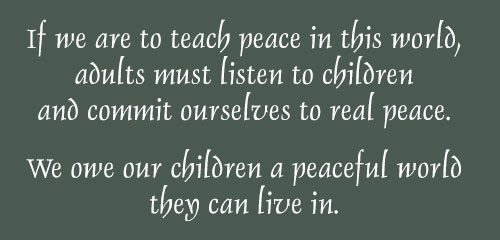

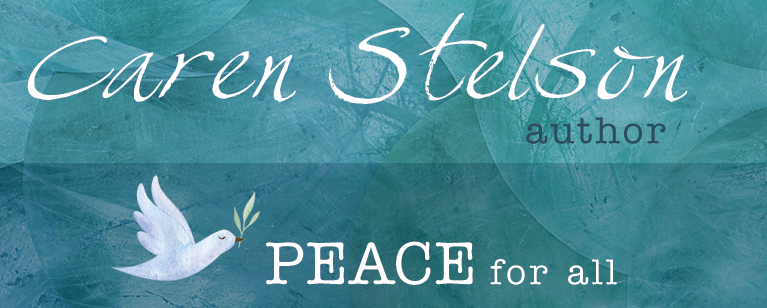
2 thoughts on “Creating a School Culture of Peace: How to …”
Nice article Caren!
Inspiring article. Thanks so much for your excellent presentation of how peace sites work. Congrats to Ms. Berry, Ms. Wood and yourself for your fine example of promoting peace!